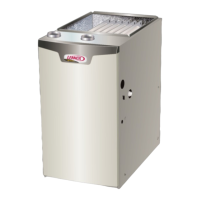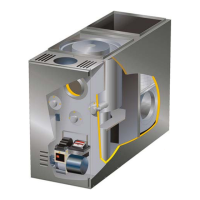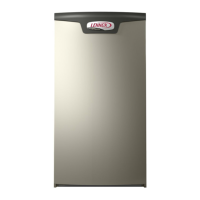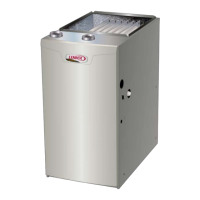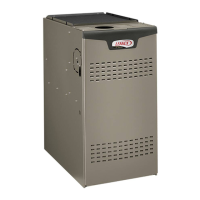Page 44
Switches 14 through 19 -- Heating Mode Blower Speed
-- These switches are factory set at the OFF position
which provides 100 % of normal speed during HIGH HEAT
demand, 70% of normal speed during MID-RANGE HEAT
demand and 35% of normal speed during LOW HEAT
demand. Switches 14, 15 and 16 are used to adjust the
LOW HEAT blower motor speed. Switches 17, 18 and 19
are used to adjust the HIGH HEAT blower motor speed.
TABLE 22 provides the heating mode blower speeds that
will result from dierent switch settings. See TABLE 23 for
allowable heating speeds.
TABLE 22
Low Heat Blower Speeds
Thermostat
Demand
Blower
Speed
Adjustments
DIP Switch Settings
Low Heat
(R to W1)
14 15 16
+ 15% On O On
+ 7.5% On O O
Normal O O O
- 7.5% On On O
- 15% On On On
TABLE 23
High Heat Blower Speeds
Thermostat
Demand
Blower Speed
Adjustments
DIP Switch Settings
High Heat
(R to W1 &
W2)
17 18 19
+ 15% On O On
+ 7.5% On O O
Normal O O O
- 7.5% On On O
- 15% On On On
On-Board Links
On-Board links must be clipped (when applicable) before
unit is placed into operation with a non-communicating
thermostat.
On-Board Link W914 (DS to R) -- FIGURE 50
On-board link W914 is a clippable connection between
terminals DS and R on the integrated control. W914 must
be cut when the furnace is installed with either the Harmo-
ny III zone control or a thermostat which features humidity
control. If the link is left intact the PMW signal from the
Harmony III control will be blocked and also lead to con-
trol damage. Refer to TABLE 25 for operation sequence
in applications including SLP99DFV, a thermostat which
features
humidity control and a single-speed outdoor unit. TABLE
26 gives the operation sequence in applications with a
two-speed outdoor unit.
On-Board Link W951 (R to O) -- FIGURE 50
On-board link W951 is a clippable connection between
terminals R and O on the integrated control. W951 must
be cut when the furnace is installed in applications which
include a heat pump unit and a thermostat which features
dual fuel use. If the link is left intact, terminal “O” will re-
main energized eliminating the HEAT MODE in the heat
pump.
On-Board Link W915 (Y1 to Y2) -- FIGURE 50
On-board link W915 is a clippable connection between
terminals Y1 and Y2 on the integrated control. W915 must
be cut if two-stage cooling will be used. If the link is not cut
the outdoor unit will operate in second-stage cooling only.
Diagnostic LED -- FIGURE 50
The seven-segment diagnostic LED displays operating
status, target airow, error codes and other information.
See ”Integrated Control Diagnostic Codes” on page 58.
Diagnostic Push Button -- FIGURE 50
The diagnostic push button is located adjacent to the sev-
en-segment diagnostic LED. This button is used to enable
the Error Code Recall mode and the Field Test mode.
Press the button and hold it to cycle through a menu of
options. Every ve seconds a new menu item will be dis-
played. When the button is released, the displayed item
will be selected. Once all items in the menu have been
displayed, the menu resumes from the beginning until the
button is released.
Error Code Recall Mode
Select ”E” from the menu to access the most recent ten
error codes. Select “c” from the Error Code Recall menu
to clear all error codes. Button must be pressed a second
time while “c” is ashing to conrm command to delete
codes. Press the button until a solid “≡” is displayed to exit
the Error Code Recall mode.
Field Test Mode
Use the diagnostic push button to scroll through the menu
as described above. Release the button when the LED
ashes “-” to select the Field Test mode. While in the Field
Test mode the technician can:
• Initiate furnace ignition and move to and hold low-re
rate by applying a R to W1 jumper.
• Initiate furnace ignition sequence and move to and hold
high-re rate by applying a jumper from R to W1 nd W2.
• Initiate furnace ignition sequence and move to and hold
mid-re rate by applying a jumper to R and W2.
• Apply then remove the jumper from R to W1 and W2 to
change the ring rate from low re to mid re and high
re.
• A vent calibration sequence can be initiated even if a
thermostat signal is not present. Press and hold the
push button until a solid “C” is displayed. Release the
button and calibration will begin. The furnace will per-
form the high-re and low-re pressure switch calibra-
tions and display “CAL”. After calibration, the LED will
return to the ashing “-” display.
During Field Test mode operation, all safety switches are
still in the circuit (they are not by-passed) and indoor blow-
er performance and timings will match DIP switch selec-
tions. Current furnace ring rate, indoor blower CFM and
ame signal will be displayed. To exit the Field Test mode,
press and hold the button. The menu will resume from the
beginning. Also, cycle the main power to exit the Field Test
mode. The integrated control will automatically exit the
Field Test mode after 45 minutes of operation.
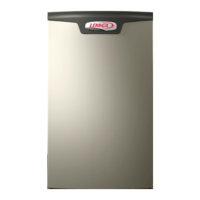
